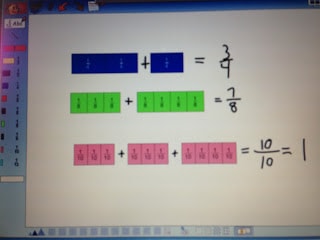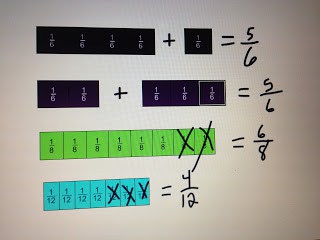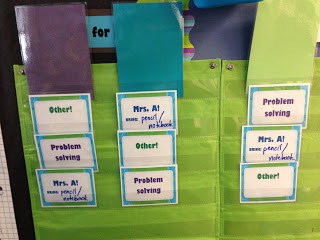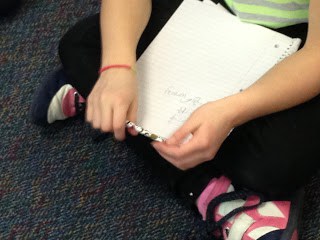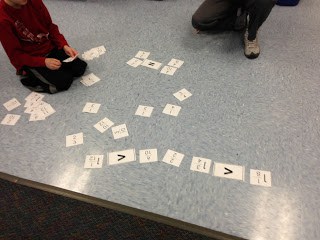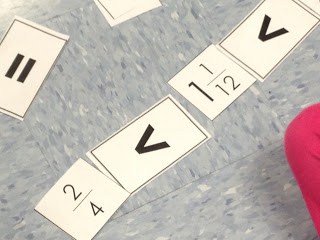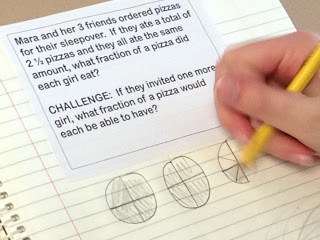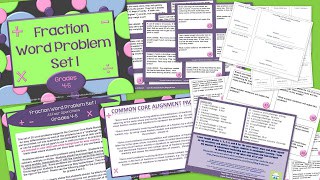Today was a math rotations day in grade 4 . . . I started the day with a minilesson and then we broke up into three math groups to rotate around the following centers:
–“teacher time”
–problem solving
–</>/= activity
Today’s minilesson focused on “composing” and “decomposing” using unit fractions, and I was hopeful that it would go smoothly. I was fairly confident based on the work we have done over the last few weeks that the students would easily manage this concept, and my students did not disappoint me.
We reviewed the idea of “unit fraction” and used the fraction bars in Kidspiration to model different ways to build fractions. We talked about how you can build or “compose” new fractions with unit fractions (which I also call counting fractions…just like we count WHOLE numbers, we can count FRACTIONS too!).
We then tied the fraction bars to a more traditional adding and subtracting notation—we modeled by counting unit fraction groups to add and by crossing out fractions to subtract. Students seemed to be really understanding, so I felt ready to send them off to do our math rotations.
Here is our rotation board:
(I’ve flipped the top cards backward to hide the names). Today’s groups were picked based on needs—I knew that I wanted to differentiate the “teacher time” rotation. Some days my groups are mixed ability–it all depends on what I am trying to accomplish. For most of the investigations we have done during this unit, my groups are entirely mixed by gender, ability, and so on.
So here were our rotations in nutshell!
1. The “teacher time” rotation was with me. We worked on reviewing the material taught in the mini lesson by having students try different combinations of addition and subtraction in their notebooks. For my strugglers, we started really slow and brought the Smartboard back up with the fraction bars so we could make the tie. By the time they were finished, we had written all sorts of different equations with addition and subtraction with like denominators. We drilled in the concept that we can only add and subtract fractions with equal parts–or else we need to do some extra work! We showed how adding 1/2 and 1/4 cannot possibly be 2/6. We worked to come up with many equations that equaled “5/8” such as …
1/8 + 2/8 + 2/8
and
7/8 – 2/8
and
4/8 + 1/8
and so on.
The other two groups were ready to move beyond this. I started by adding in both improper fractions and mixed numbers for them and things seemed to be moving pretty smoothly. I asked them to find many equations with the solution 1 3/4 and they handled that as well. I then decided to work on true/false problems with them so I threw out problems such as
5/8 + 2/8 < 3 x 1/3 True or False?
and
4 1/4 – 3 3/4 > 1/2 True or False?
The students handled the multiplication with ease–they have such good number sense that they realize that three “1/3’s” is a whole–no computation required!
We then started playing more with improper fractions and the students tried writing problems to stump each other–tons of fun and very developmentally appropriate for each group.
2. The second rotation was a free explore station with fraction cards and <, >, and = cards. I gave the students a number of different ways to interact with the cards…
–they could flip two cards over and decide which symbol would go between them
–they could flip 5 cards and put them in order smallest to largest
–they could flip two cards over and find 2 more cards that would fit between them
–they could come up with their own sequencing practice
And practice they did! Each time I asked this group to rotate, they MOANED! Can you believe? They MOANED that they had to stop sequencing fractions! I heard some fantastic discussion and some very creative thinking. One group even decided to try to take a larger fraction card and find smaller ones that they could “decompose” the larger one into. Really? So much fun! For those of you who have purchased the fraction sequencing set, this is one of the activities in that resource. I will include it in the unit as well.
3. The final rotation was a problem solving station. Because I felt the students have enough number sense and addition/subtraction skills now, I was ready to send them off to try to tackle some word problems with fractions. I will include these problems in my unit, but for those of you who aren’t interested in purchasing the big unit in a few weeks (I promise I will work as hard as I can to get it done in the next 1-2 weeks), the set of word problems IS available in my store now. I will put the link at the bottom of this post. I let the students buddy up if they wanted. I was super pleased with what I saw! I will save one example of some great teamwork for another post!
Here is the teaser for the next post! This was the “a ha” problem for one of my students today!
So, I hope you get a taste for one way I organize my math time . . . many of my lessons have been very “investigation” oriented–today was a more “guided math” approach which allowed me to really dig in and see how far certain students can be pushed. Tomorrow–more problem solving and small group pulling based on the 3 exit slips I have given this week. I have a few petunias who need a little more work with equivalent fractions and comparing fractions–so while the class has rotations tomorrow, I will be pulling small groups instead of having a “teacher time” rotation.
Thanks for stopping by! Stay tuned . . .

